2014 Peugeot 308 ECO mode
[x] Cancel search: ECO modePage 3 of 400
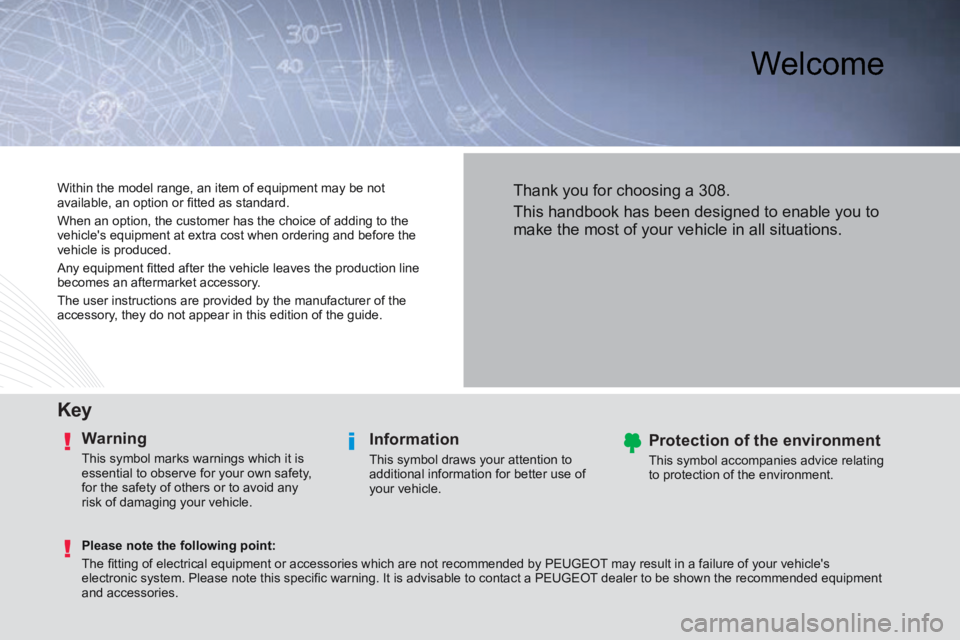
Welcome
Key
Warning
This symbol marks warnings which it is
essential to observe for your own safety,
for the safety of others or to avoid any
risk of damaging your vehicle.
Information
This symbol draws your attention to
additional information for better use of
your vehicle.
Protection of the environment
This symbol accompanies advice relating
to protection of the environment.
Thank you for choosing a 308.
This handbook has been designed to enable you to
make the most of your vehicle in all situations.
Please note the following point:
The fi tting of electrical equipment or accessories which are not recommended by PEUGEOT may result in a failure of your vehicle's
electronic system. Please note this specifi c warning. It is advisable to contact a PEUGEOT dealer to be shown the recommended equipment
and accessories.
Within the model range, an item of equipment may be not
available, an option or fi tted as standard.
When an option, the customer has the choice of adding to the
vehicle's equipment at extra cost when ordering and before the
vehicle is produced.
Any equipment fi tted after the vehicle leaves the production line
becomes an aftermarket accessory.
The user instructions are provided by the manufacturer of the
accessory, they do not appear in this edition of the guide.
Page 5 of 400

Contents
308_EN_CHAP00A _SOMMAIRE_ED02-2013
M i r r o r s 170
Lighting 173
Daytime running lamps 177
Automatic illumination of headlamps 178
Headlamp adjustment 180
Wipers 181
Automatic rain sensitive wipers 183
Courtesy lamps 185
Interior mood lighting 186
Temporary puncture repair kit 221
Changing a wheel 227
Snow chains 234
Changing a bulb 235
Changing a fuse 245
12 V battery 251
Energy economy mode 255
Changing a wiper blade 256
Towing the vehicle 257
Very cold climate screen 259
Towing a trailer 260
Fitting roof bars 262
Accessories 264
Bonnet 267
Petrol engine 268
Diesel engine 269
Running out of fuel (Diesel) 270
Additif AdBlue® additive and SCR system ® additive and SCR system ®
(Blue HDi Diesel) 271
Checking levels 280
Checks 283
Engines 285
Weights 285
Dimensions 286
Identifi cation markings 287
Direction indicators 187
Hazard warning lamps 187
Emergency or assistance call 188
Horn 188
Tyre under-infl ation detection 189
ESC system 193
Seat belts 196
Airbags 199
Child seats 204
Deactivating the passenger's front airbag 207
ISOFIX child seats 213
Child lock 220
Visibility
Safety Practical information
Checks Technical data
.
Emergency or assistance
289
DENON equipment 291
Touch screen 293
PEUGEOT Connect Sound (RD5) 365
Audio equipment and telematics
Alphabetical index
Page 11 of 400

9
.Visual search
308_EN_CHAP00B_ AIDE VISUELLE_ED02-2013
Maintenance - Technical data
Dimensions 286 Identification markings 287
Running out of fuel, Diesel 270
Checking levels 280 -282 - oil - brake fluid - coolant - screenwash, headlamp wash fluid - additive (Diesel with particle emissions filter) Checking components 283 -284 - battery - air / passenger compartment filter - oil filter - particle emissions filter (Diesel) - brake pads / discs
Changing bulbs 235-244 - front - rear
12V battery 251-254 Load reduction, economy mode 255 Engine compartment fuses 245, 249 -250
Opening the bonnet 267 Under the bonnet, petrol 268 Under the bonnet, Diesel 269 Petrol engines 285 AdBlue 271-279
Weights 285
Page 12 of 400

10
Eco-driving
308_EN_CHAP00C_ECO CONDUITE_ED02-2013
Optimise the use of your gearbox
With a manual gearbox, move off gently and change up without waiting. During acceleration change up early.
With an automatic or electronic gearbox, give preference to automatic mode and avoid pressing the accelerator pedal heavily or suddenly.
Control the use of your electrical
equipment
Before moving off, if the passenger compartment is too warm, ventilate it by opening the windows and air vents before using the air conditioning. Above 30 mph (50 km/h), close the windows and leave the air vents open. Remember to make use of equipment that can help keep the temperature in the passenger compartment down (sunroof and window blinds...). Switch off the air conditioning, unless it has automatic regulation, as soon as the desired temperature is attained. Switch off the demisting and defrosting controls, if not automatic. Switch off the heated seat as soon as possible.
Switch off the headlamps and front foglamps when the level of light does not require their use.
Avoid running the engine before moving off, particularly in winter; your vehicle will warm up much faster while driving.
As a passenger, if you avoid connecting your multimedia devices (film, music, video game...), you will contribute towards limiting the consumption of electrical energy, and so of fuel. Disconnect your portable devices before leaving the vehicle.
Eco-driving
Eco-driving is a range of everyday practices that allow the motorist to optimise their fuel consumption and CO2 emissions.
Drive smoothly
Maintain a safe distance between vehicles, use engine braking rather than the brake pedal, and press the accelerator progressively. These practices contribute towards a reduction in fuel consumption and CO2 emissions and also helps reduce the background traffic noise.
If your vehicle has cruise control, make use of the system at speeds above 25 mph (40 km/h) when the traffic is flowing well.
The gear shift indicator invites you engage the most suitable gear: as soon as the indication is displayed in the instrument panel, follow it straight away. For vehicles fitted with an electronic or automatic gearbox, this indicator appears only in manual mode.
Page 15 of 400
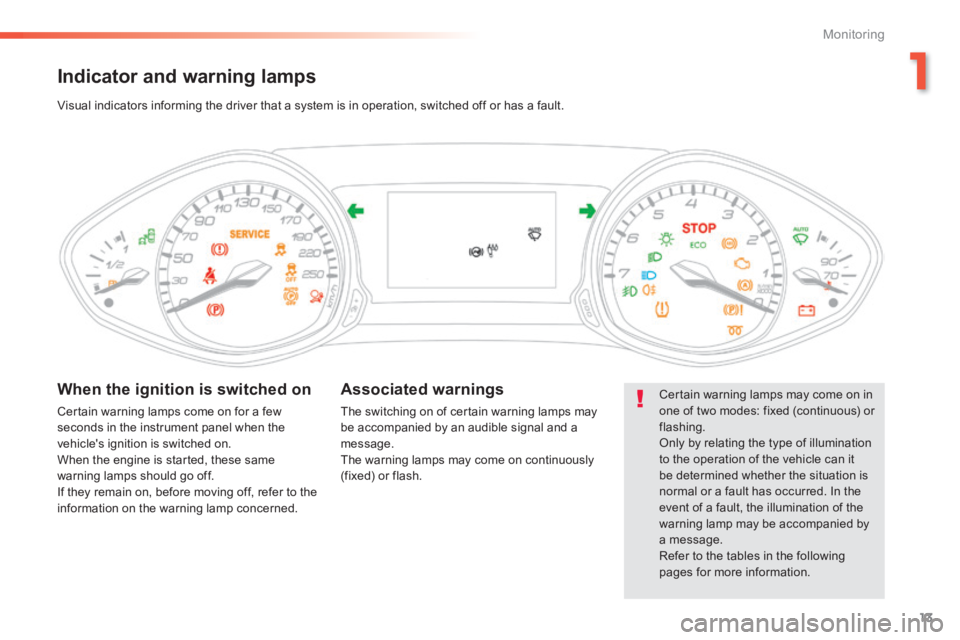
13
1
Monitoring
308_EN_CHAP01_CONTROLE DE MARCHE_ED02-2013
Indicator and warning lamps
Certain warning lamps may come on in one of two modes: fixed (continuous) or flashing. Only by relating the type of illumination to the operation of the vehicle can it be determined whether the situation is normal or a fault has occurred. In the event of a fault, the illumination of the warning lamp may be accompanied by a message. Refer to the tables in the following pages for more information.
Visual indicators informing the driver that a system is in operation, switched off or has a fault.
When the ignition is switched on
Certain warning lamps come on for a few seconds in the instrument panel when the vehicle's ignition is switched on. When the engine is started, these same warning lamps should go off. If they remain on, before moving off, refer to the information on the warning lamp concerned.
Associated warnings
The switching on of certain warning lamps may be accompanied by an audible signal and a message. The warning lamps may come on continuously (fixed) or flash.
Page 18 of 400
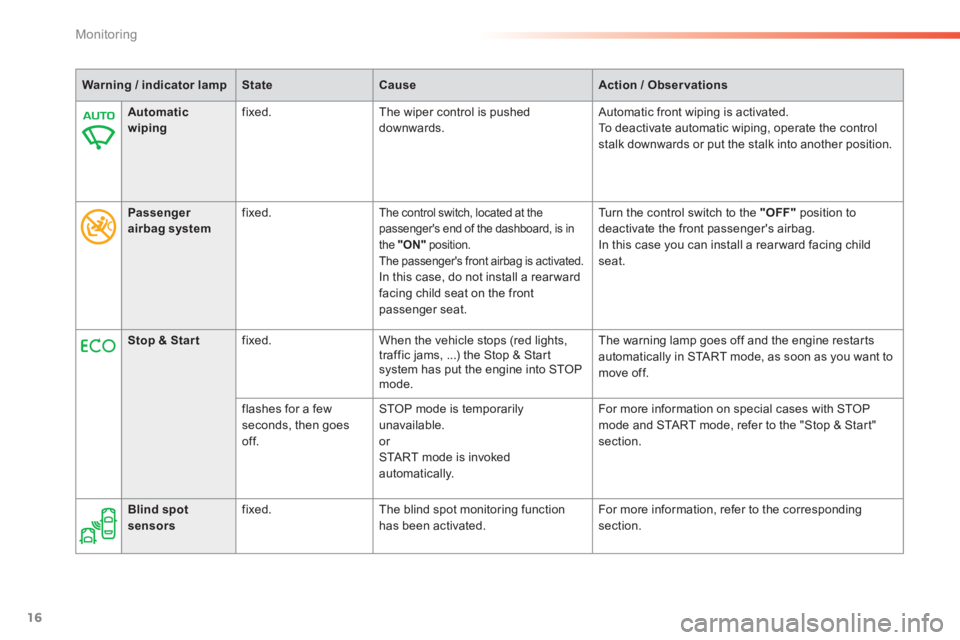
16
Monitoring
308_EN_CHAP01_CONTROLE DE MARCHE_ED02-2013
Warning / indicator lampStateCauseAction / Observations
Automatic wiping fixed. The wiper control is pushed downwards. Automatic front wiping is activated. To deactivate automatic wiping, operate the control stalk downwards or put the stalk into another position.
Passenger airbag system fixed. The control switch, located at the passenger's end of the dashboard, is in the "ON" position. The passenger's front airbag is activated. In this case, do not install a rear ward facing child seat on the front passenger seat.
Turn the control switch to the "OFF" position to deactivate the front passenger's airbag. In this case you can install a rear ward facing child seat.
Stop & Star t fixed. When the vehicle stops (red lights, traffic jams, ...) the Stop & Start system has put the engine into STOP mode.
The warning lamp goes off and the engine restarts automatically in START mode, as soon as you want to move off.
flashes for a few seconds, then goes of f.
STOP mode is temporarily unavailable. or START mode is invoked automatically.
For more information on special cases with STOP mode and START mode, refer to the "Stop & Start" section.
Blind spot sensors fixed. The blind spot monitoring function has been activated. For more information, refer to the corresponding section.
Page 37 of 400
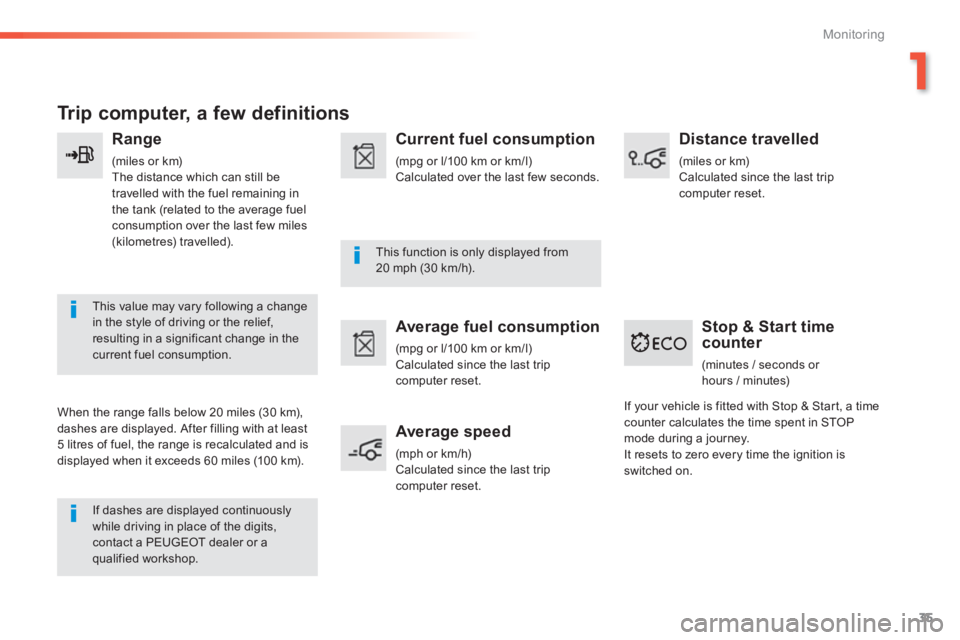
35
1
Monitoring
308_EN_CHAP01_CONTROLE DE MARCHE_ED02-2013
Trip computer, a few definitions
Range
(miles or km) The distance which can still be travelled with the fuel remaining in the tank (related to the average fuel consumption over the last few miles (kilometres) travelled).
This value may vary following a change in the style of driving or the relief, resulting in a significant change in the current fuel consumption.
When the range falls below 20 miles (30 km), dashes are displayed. After filling with at least 5 litres of fuel, the range is recalculated and is displayed when it exceeds 60 miles (100 km).
If dashes are displayed continuously while driving in place of the digits, contact a PEUGEOT dealer or a qualified workshop.
This function is only displayed from 20 mph (30 km/h).
Current fuel consumption
(mpg or l/100 km or km/l) Calculated over the last few seconds.
Average fuel consumption
(mpg or l/100 km or km/l) Calculated since the last trip computer reset.
Average speed
(mph or km/h) Calculated since the last trip computer reset.
Distance travelled
(miles or km) Calculated since the last trip computer reset.
Stop & Start time counter
(minutes / seconds or hours / minutes)
If your vehicle is fitted with Stop & Start, a time counter calculates the time spent in STOP mode during a journey. It resets to zero every time the ignition is switched on.
Page 104 of 400
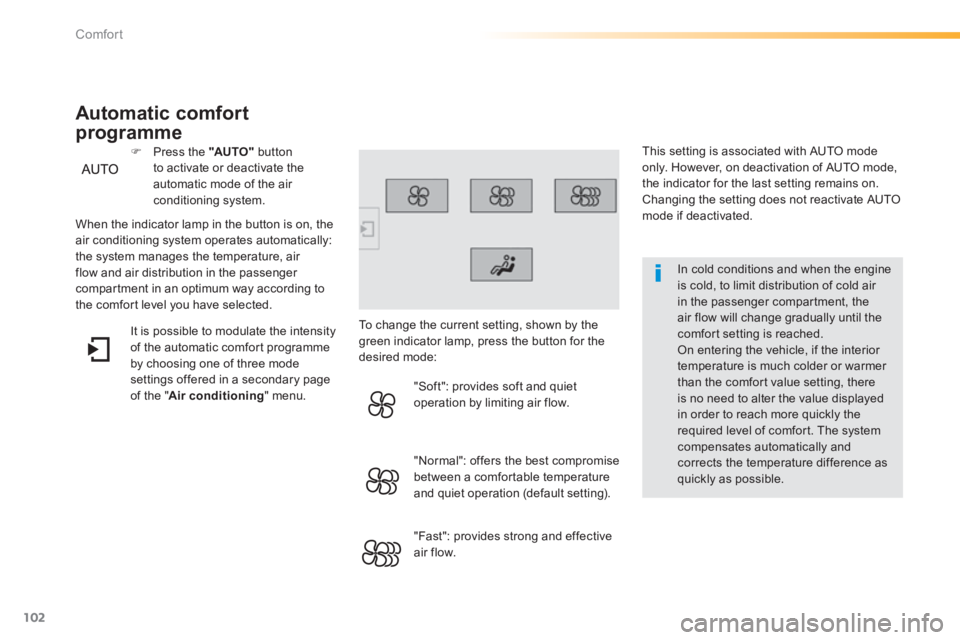
102
Comfort
308_EN_CHAP03_CONFORT_ED02-2013
In cold conditions and when the engine is cold, to limit distribution of cold air in the passenger compartment, the air flow will change gradually until the comfort setting is reached. On entering the vehicle, if the interior
temperature is much colder or warmer than the comfort value setting, there is no need to alter the value displayed in order to reach more quickly the required level of comfort. The system compensates automatically and corrects the temperature difference as quickly as possible.
This setting is associated with AUTO mode only. However, on deactivation of AUTO mode, the indicator for the last setting remains on. Changing the setting does not reactivate AUTO mode if deactivated. When the indicator lamp in the button is on, the air conditioning system operates automatically: the system manages the temperature, air flow and air distribution in the passenger compartment in an optimum way according to the comfort level you have selected.
Press the "AUTO" button to activate or deactivate the automatic mode of the air conditioning system.
Automatic comfort
programme
To change the current setting, shown by the green indicator lamp, press the button for the desired mode:
"Soft": provides soft and quiet operation by limiting air flow.
"Normal": offers the best compromise between a comfortable temperature and quiet operation (default setting).
"Fast": provides strong and effective air flow.
It is possible to modulate the intensity of the automatic comfort programme by choosing one of three mode settings offered in a secondary page of the " Air conditioning " menu.